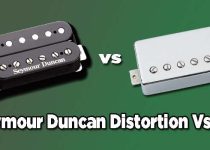Bridge or Neck Pickup for Rhythm [You Should Know]
In the vast realm of electric guitars, the eternal debate between the bridge and neck pickup for rhythm playing has fueled countless discussions among musicians. Each pickup possesses its unique sonic fingerprint, influencing the overall character and tone of your playing.

In this guide, we will talk about the intricacies of the bridge and neck pickups, exploring when to choose the ideal pickup for a rhythm guitar.
# Table of Contents =>
Why Choose the Bridge Pickup for Rhythm?
a) Unleashing the Power of Precision:
The bridge pickup, typically mounted closer to the guitar’s bridge, is renowned for its precision and attack. When engaged for rhythm playing, the bridge pickup delivers a sharp and cutting tone that slices through the mix with clarity. The enhanced treble response of the bridge pickup allows for articulate chord definition, making it an excellent choice for genres like rock, metal, and punk where a tight rhythm is paramount.
b) Embracing the Bright Side:
One of the key characteristics of the bridge pickup is its brightness. This brightness lends itself well to rhythm parts, especially when you want your chords to ring out with clarity and punch. Whether you’re playing jangly clean chords or aggressive power chords, the bridge pickup adds a crisp edge to your sound that can be particularly advantageous in a band setting.
c) Cutting Through the Mix:
In a band context, cutting through the mix is crucial for a rhythm guitarist. The bridge pickup’s focused and sharp tones make it easier for your guitar to be heard clearly alongside other instruments. It helps your playing stand out without being drowned by the bass or overshadowed by the lead guitar, providing a sonic anchor for the entire band.
How to Make the Most of the Bridge Pickup for Rhythm:
a) Dialing in the Right Tone –
Achieving the perfect tone with the bridge pickup involves finding the right balance. Experiment with your guitar’s tone controls and amplifier settings to tame any excessive brightness and sculpt a sound that complements your playing style. Adding a touch of compression can also help control dynamics and ensure a consistent tone.
b) Mastering Palm Muting Techniques –
The bridge pickup excels at delivering tight palm-muted chugs and staccato rhythms. To make the most of this capability, focus on refining your palm muting technique. Adjust your palm placement on the strings and experiment with different degrees of pressure to find the sweet spot that produces a controlled, percussive sound.
c) Embracing Dynamic Playing –
While the bridge pickup is known for its precision, it is equally responsive to dynamic playing. Experiment with your picking intensity to explore the full range of tones the bridge pickup can offer. Use lighter picking for cleaner, chime-like tones, and dig in for a more aggressive, driven sound.
When to Opt for the Neck Pickup for Rhythm:
a) Unveiling the Warm Embrace –
In contrast to the bright and cutting nature of the bridge pickup, the neck pickup resides closer to the guitar’s neck, offering a warmer, rounder tone. Choosing the neck pickup for rhythm imparts a lush, full-bodied quality to your chords. It is making it an excellent choice for genres like jazz, blues, and classic rock.
b) Tapping into the Smooth Sustain –
The neck pickup’s position captures vibrations near the guitar’s midpoint, enhancing sustain and resonance. When playing rhythm, especially in slower tempos or ballads, the neck pickup’s smooth sustain can add a beautiful legato quality to your chords. This sonic characteristic is particularly advantageous for creating emotive and expressive rhythm parts.
c) Crafting Tonal Variations –
The neck pickup’s inherently warmer tone provides an excellent canvas for tonal exploration. Experiment with your guitar’s volume and tone controls to sculpt a diverse range of sounds. Rolling off the tone knob slightly can produce a mellower, jazzier vibe, while pushing the volume can add a touch of grit and edge to your rhythm playing.
How to Harness the Neck Pickup for Rhythm:
1. Finding the Right Balance:
The neck pickup’s warmth can sometimes lead to a loss of clarity, especially in fast and intricate rhythm sections. To mitigate this, find the right balance between the neck pickup’s fullness and the necessary definition for your playing style. Adjust your amp settings and experiment with EQ to maintain clarity without sacrificing the desired warmth.
2. Utilizing Fingerstyle Techniques:
The neck pickup’s smooth and round character makes it an ideal partner for fingerstyle playing. Explore fingerpicking techniques to unlock the full potential of the neck pickup for rhythm. The added expressiveness and nuance afforded by fingerstyle playing can elevate your rhythm parts to new heights.
3. Embracing Chord Voicings:
The neck pickup’s enhanced sustain allows for more extended chord voicings and arpeggios. Experiment with different chord shapes and inversions to take advantage of the neck pickup’s ability to ring out chords with a rich, sustaining quality. This is particularly effective in genres that emphasize harmonic complexity, such as jazz and fusion.
Conclusion:
In the eternal battle of bridge vs. neck pickup for rhythm, there is no definitive winner – only personal preference and artistic choice. Understanding the unique characteristics of each pickup allows you to make informed decisions based on the sonic palette you wish to paint with your playing.
Whether you opt for the precision and brightness of the bridge pickup or the warmth and sustain of the neck pickup, the key lies in experimenting, refining, and ultimately discovering the sonic landscape that best complements your rhythm guitar journey. So, pick up your guitar, explore the realms of the bridge and neck pickups, and let the rhythmic symphony unfold.
Last Updated on December 5, 2023 by Perry Garner


